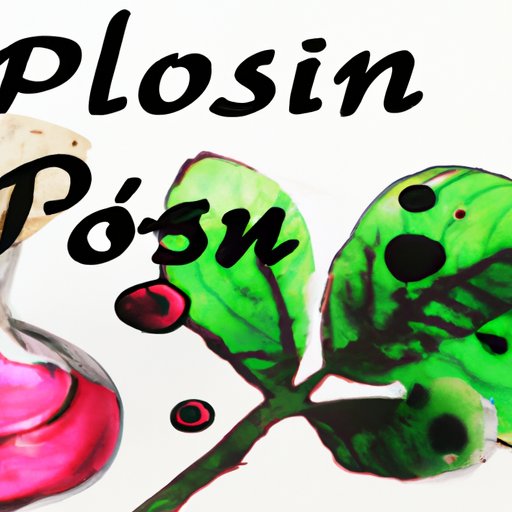
I. Introduction
Poison ivy rash is a common skin problem that can cause irritation, itching, and even blisters. It happens when you come in contact with the leaves, stems, or roots of the poison ivy plant. In this article, we will discuss how to get rid of poison ivy rash with 10 natural remedies and tips for prevention and relief.
II. 10 Natural Remedies to Ease Poison Ivy Rash
1. Aloe vera: Apply aloe vera gel directly to the affected area for its anti-inflammatory and healing properties.
2. Oatmeal baths: Adding colloidal oatmeal to your bathwater can soothe and relieve itchy skin.
3. Apple cider vinegar: Mix apple cider vinegar with water and apply to the affected area for its antifungal and antibacterial properties.
4. Tea tree oil: Dilute tea tree oil with a carrier oil and apply to the rash for its antifungal and anti-inflammatory properties.
5. Witch hazel: Apply witch hazel directly to the rash for its astringent properties that can reduce itching and inflammation.
6. Baking soda: Mix baking soda with water to create a paste and apply to the rash for its alkaline properties that can help alleviate itching.
7. Cucumber: Cut a cucumber into thin slices and place them on the affected area for its cooling and anti-inflammatory properties.
8. Banana peel: Rub the inside of a banana peel on the rash for its cooling and soothing properties.
9. Chamomile tea bags: Brew chamomile tea and soak a cloth or cotton balls in it to apply to the rash for its anti-inflammatory and healing properties.
10. Cold water compress: Soak a cloth in cold water and apply to the rash for its cooling and soothing properties.
III. Why Prevention is Key: Tips to Avoid Poison Ivy Rash
Preventing poison ivy rash is the best way to avoid the discomfort and inconvenience it can cause. Here are some tips for prevention:
– Learn to identify poison ivy: Know what the plant looks like and where it commonly grows.
– Wear protective clothing: Wear long sleeves, pants, gloves, and closed-toe shoes when in areas where poison ivy grows.
– Avoid touching poison ivy: Do not touch or pick the plant, and avoid hiking or camping in areas where it grows.
– Wash clothing and body after exposure: If you have come in contact with poison ivy, wash your clothes and take a shower to remove any oils that may cause a rash.
– Keep pets from exposure: Avoid letting your pets roam in areas where poison ivy grows, as they can transfer the oils from their fur to you.
IV. Over-The-Counter Creams for Poison Ivy Rash Relief
If natural remedies are not enough to relieve your poison ivy rash, over-the-counter creams may be helpful. These include:
– Hydrocortisone cream: An anti-inflammatory cream that can reduce itching and swelling.
– Calamine lotion: A cooling lotion that can relieve itching and soothe irritation.
– Benadryl cream: A topical antihistamine that can reduce itching and swelling.
– Domeboro solution: A medicated soak that can dry out blisters and relieve itching.
– Prescription-strength options: Your doctor may prescribe stronger medications or steroids to relieve severe symptoms.
V. When to Seek Medical Attention for Poison Ivy Rash
Although most poison ivy rashes can be treated at home, there are times when medical attention is necessary. Seek medical attention if you experience:
– Severe symptoms: If your rash covers a large area of your body or is accompanied by severe swelling, difficulty breathing, or a fever.
– Symptoms that do not improve: If your rash does not improve after a week or is getting worse.
– Signs of infection: If your rash is oozing, blistering, or accompanied by pus or a foul odor.
– Allergic reaction: If you experience a severe allergic reaction, such as hives, swelling, or difficulty breathing.
– Treatment options: Your doctor may prescribe stronger medications or steroids to relieve severe symptoms.
VI. Home remedies that will make you uncomfortable during poison ivy rash
There are many home remedies for poison ivy rash that may make you uncomfortable. Here are some remedies to avoid:
– Oatmeal bath while wearing a onesie: This may relieve itching, but it is not the most comfortable way to spend your time.
– Tickle fight while coated in calamine lotion: This may sound fun, but it can be messy and uncomfortable.
– Sleeping in a bathtub: This may relieve itching and cool your skin, but it is not a comfortable way to sleep.
– Coconut oil sunburn remedies: While coconut oil may have some moisturizing properties, it can actually trap heat and make a sunburn or poison ivy rash worse.
– Toothpaste on bug bites: While toothpaste can relieve itching from bug bites, it can actually irritate and dry out your skin if used on poison ivy rash.
VII. Conclusion
Poison ivy rash can be a nuisance but is manageable with natural remedies and preventive measures. If symptoms persist or worsen, seek medical attention. Remember to avoid home remedies that may make you uncomfortable and keep in mind prevention tips to avoid contact with poison ivy.




